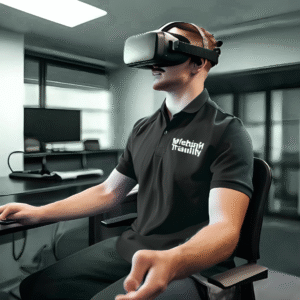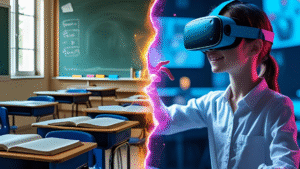Introduction
Learning has come a long way from what it used to be. Books and chalkboards were once enough, but not anymore. Today’s world is fast, tech-heavy, and deeply visual. Students and professionals alike are craving something more real, more hands-on.
Virtual Reality, or VR, isn’t just a futuristic idea anymore. It’s here and it’s doing big things in education and job training. Imagine being able to rehearse a heart surgery, handle heavy construction equipment, or lead a business meeting all inside a headset. Sounds wild, but it’s very real, and it’s happening right now.
Let’s take a look at how VR is quietly but powerfully changing how we teach, train, and learn in 2025.

Why Old-School Methods Are Falling Behind?
In many places, teaching still relies on static presentations, printed notes, and long lectures. But sitting through a two-hour talk or flipping through a PDF doesn’t always help people actually learn. For things that involve risk or hands-on skill like welding, flying, or even giving CPR you just can’t “get it” without doing it.
That’s where traditional methods fall short. They inform, but they don’t always prepare. VR changes that by putting you into the experience itself. Instead of just reading about it, you live it.
What Makes VR So Useful in Training?
When you wear a VR headset, you’re not watching from the sidelines, you’re inside the lesson. You’re moving, deciding, reacting. It doesn’t feel like studying, it feels like doing.
What’s great is that you can mess up without real consequences. Make a mistake? Try again. No damage, no danger. That’s a huge win in fields where errors can be costly or even deadly. Also, people tend to remember better when they’re part of the action, not just watching it.
How VR Is Being Used in Real Settings?
Corporate Skill Building
Companies are moving away from outdated training manuals and PowerPoint sessions. Instead, they’re using VR to place employees in simulated environments like handling a tough client call, leading a team meeting, or learning negotiation. ZATSIM, for example, builds these kinds of tailored experiences for real business situations.
Medical and Healthcare Training
Instead of relying solely on textbooks and real-time observation, medical students and professionals now practice in virtual clinics and operating rooms. Whether it’s learning to treat trauma cases or mastering surgical techniques, VR lets them repeat procedures as many times as they need without any risk to real patients.
Classroom Learning at Schools and Colleges
Instead of reading about planets or chemical reactions, students can now explore space or conduct lab experiments in a virtual environment. A classroom trip to the pyramids or inside a human cell doesn’t require travel anymore — just a headset.
Technical and Safety Training
Industries with high-risk tasks like construction, firefighting, or machinery handling are increasingly using VR to train workers. Employees can go through drills, operate equipment, or practice safety protocols without being exposed to actual hazards. It’s hands-on training, minus the real-world danger.

Why More Organizations Are Jumping Onboard?
VR grabs your attention in a way that books or slides never could. When someone is inside a virtual scene, they stay focused. They remember what they did, not just what they saw or heard.
Also, once a company builds a VR training module, it can use it over and over. That saves time and money in the long run. Plus, the same module can be shared across offices in different cities or even countries. Everyone gets the same high-quality training with no variation or inconsistency.
Not Everything's Perfect Yet
It’s not all smooth sailing. Good VR systems don’t come cheap, and designing content takes time. Some users feel disoriented or tired during longer sessions, and in places with slow internet or limited hardware, access can be a barrier.
But tech keeps moving. Prices are coming down, internet speed is going up, and content creators are getting better at making things efficient and user-friendly. The road’s not without bumps, but it’s definitely moving forward.
What ZATSIM Is Really Doing?
ZATSIM didn’t start with big claims. We started with a simple question: how can training in Pakistan be made more real, more hands-on, and less dependent on outdated methods?
Over the past few years, we’ve worked with hospitals, factories, schools, and offices and every project has taught us something new. One organization wanted to train medical staff without putting patients at risk. Another needed workers to handle machinery safely, without shutting down production. That’s where we came in.
We don’t offer ready-made templates. Every simulation we create is built around the people who’ll actually use it. It’s not about tech for the sake of tech. It’s about solving real training problems in smarter ways.
Conclusion
Let’s be honest. The way we train people is overdue for an upgrade. Virtual Reality is giving us that chance. It’s not some luxury gadget anymore. It’s practical, powerful, and in many cases, better than traditional methods.
In a place like Pakistan, where fast growth often means fast challenges, VR can fill the gap especially when companies like ZATSIM are leading the way. We’re not replacing human learning, just making it smarter and more future-ready.
